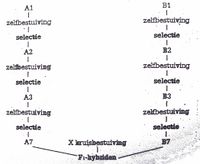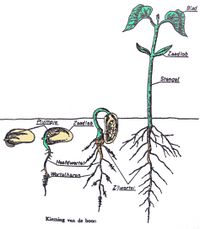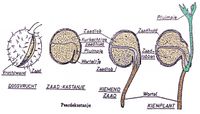m (Bot: Adding {{catneeded}} tag to uncategorized pages) |
|||
| Line 105: | Line 105: | ||
===[http://en.wikipedia.org/wiki/Cutting_%28plant%29 Stem cuttings]=== | ===[http://en.wikipedia.org/wiki/Cutting_%28plant%29 Stem cuttings]=== | ||
Most used method | Most used method, | ||
most economicly intresting method for many plants | |||
General rule: | General rule: | ||
cuttings of herbaceous plants in spring | cuttings of herbaceous plants in spring | ||
cuttings of woody plants: the | cuttings of woody plants: in the resting periode | ||
Choice of | *Choice of cuttings | ||
mother plant cut back significantly | *mother plant needs to be cut back significantly to attain a a variety of young twigs | ||
season plays major role: woody cuttings in spring just after the buds begin to sprout in autumn is less chance of success but | *season plays a major role: woody cuttings in spring just after the buds begin to sprout, in autumn there is less chance of success but stronger material is attained that will dry out less quickly | ||
heat: too hot; | *heat: too hot; development of growing point but no root formation | ||
cool above ground, | cool above ground, hot below ground | ||
===Leaf bud cuttings=== | |||
of evergreen plants | |||
possible | possible with any type of stem, woody, semi-woody, herbaceous | ||
Aucuba, Ceanothus, Daphne, Elaeagnus, Cherry | Aucuba, Ceanothus, Daphne, Elaeagnus, Cherry laurel | ||
taken from matured stems that are almost completely woody, have leaves and therefore no complete resting period. Time: end of summer, early autumn | |||
===Heely stem cuttings=== | |||
a young side shoots from the parent plant which | a young side shoots pulled from the parent plant in which a heel (= a piece of bark) is torn along. Reason: increased density of cells with growth opportunities in cambium. Very good for plants that require a longer time to root. | ||
Eg: Buxus | Eg: Buxus | ||
===Herbaceous top cuttings=== | |||
Not yet | Not yet matured and ripened off branches. Are very fragile but root fast. The younger the shoot, the faster they will catch on. Herbaceous shoots develop during growth and lignify as they get grow older. Herbaceous shoots are taken from rapidly growing top shoots in the spring . It is done the minute the buds start to grow and when the root formation is very active. Later is also possible, but then we need to climatise the cuttings as they are very sensitive to dehydration. When a cutting has wilted, there is even no more root formation. | ||
Herbaceous shoots | Swell in water. | ||
Perovska, Hypericum. | |||
===Halfwoody cuttings=== | |||
more woody cuttings | more woody cuttings | ||
berries. Ceanothus, Chrysanthemum, Delphinium, Forsythia, Geranoum, Philadelphus. Time: end of spring when growth begins to weaken. | berries. Ceanothus, Chrysanthemum, Delphinium, Forsythia, Geranoum, Philadelphus. Time: end of spring when growth begins to weaken. | ||
===Almost matured cuttings=== | |||
Deutzia, Cornus species with colored bark | Deutzia, Cornus species with colored bark | ||
At the end of the growing season, | At the end of the growing season, stronger, thicker cuttings | ||
much | much growing strength but increased risk of dehydration | ||
===Woody cuttings=== | |||
In plants with strong vigor: Salix, Cotoneaster, poplar, wild roses, ornamental plums, Spiraea, Viburnum, | In plants with strong vigor: Salix, Cotoneaster, poplar, wild roses, ornamental plums, Spiraea, Viburnum, | ||
made of strong shoots | made of strong shoots | ||
| Line 147: | Line 149: | ||
bottom: right | bottom: right | ||
===Cuttings of half shrubs=== | |||
Some low growing plants, often herbaceous, shrubs called half: | Some low growing plants, often herbaceous, shrubs called half: | ||
Artemisia, Hypericum calycinum, lavender, rosemary, rue, sage, santolina | Artemisia, Hypericum calycinum, lavender, rosemary, rue, sage, santolina | ||
| Line 153: | Line 155: | ||
end of summer, preferably non-flowering shoots are cut off, otherwise cut flower | end of summer, preferably non-flowering shoots are cut off, otherwise cut flower | ||
===Grafting/occulating=== | |||
[[Category:Agriculture_manual]] | |||
Revision as of 14:47, 18 December 2009
Part 3: PLANT PROPAGATION
Generative propagation
Selective breeding
Seed is made after a pollination in which pollen from a male flower has fallen on the pistil of a female flower. As the characteristics of the two plants blend together, a large difference between the different descendants will occur. Trough selection, the majority of the plants with differentiating characteristics can be removed so that seedlings are kept that are equal in all respects. Most vegetables, herbs and one and two year-flowers are made after years of selection, until a high degree of uniformity is reached. It is then said that the properties are "set", or "fixed". Non-selectively bred species will have a wide variety in charisteristics for their descendants after sowing.
Self-pollinating crops These are sometimes propogated by open pollination. The offspring differ very little. These crops are "fixed". Examples are the common bean and the tomato. These plants are homozygous.
Cross-pollinating crops These are not propagated by open pollination because the offspring then differ too much. The reason is that the plants are heterozygous.
F1-hybrids: Hybrids are bastards. They are made to get a batch of plants that are (almost) identical to each other. We start from 2 selectively-bred or fixed species or varieties. These are obtained by forced self-pollination and the descendants are also repeatedly propagated by a forced self-pollination. This process is called inbreeding. A number of homozygous plants made that are called inbred bloodlines. With these inbred bloodlines, the charisteristics are fixed. Many cross-pollinators do not tolerate self-pollination and show inbreeding depression. They will begin to exhibit defections and become less vigorous in growth. However, such inbred bloodlines are used to create F1 hybrids. Two inbred bloodlines are then crossed with each other. The descendants all exhibit the same characteristics and become strengthened by the heterosiseffect. They are usually stronger, bigger and nicer than the parents. Given that the characteristics of these hybrids are thus no longer fixed, the crossing of F1-hybrids will result in the reintroduction of the charisteristics of both parents and the descendants will no longer be as uniform. Certain desired characteristics will also be lost. The parent lines of self-pollinators are maintained by generative propagation, the parent lines of cross-pollinaters are maintained by vegetative propagation.

A7 X B7 is a cross pollination; which is also the final step
The germination
Requirements
Internal requirements
- The seed is in good condition, if:
Morfologically: all parts are present and intact Physiologically: sufficient food reserves are present that are enough dehydrated and do not have vacuoles
- The seed must be ripe: Some seeds do not germinate in spite of favorable conditions. They must undergo a maturation process. For certain seeds, a fairly severe frost period is required (apple, pear). The reserve nutrition is be converted into assimilatable form and inhibitor compounds must have been dissolved (stratification process).
- The seed must be germamble: it needs to be capable of germing under the normal conditions. The germination is greatly reduced with the age of the seed.
- Seeds that lose germination strength quickly: food reserves stored in the form of oil or fat (coffee and oilseeds)
- Seeds that keep their germination strength a long time: food reserves stored in the form of carbohydrates (cereals, broom)
External requirements
- Sufficient moisture for seed skin and germination: Water can more difficultly penetrate into a hard seed coat and germination lasts longer eg: clover.
- Suitable temperature: germination is only barely possible at the minimum temperature. At the optimum temperature, the germination is the fastest. Above the maximum temperature, the germination strength is destroyed. Ex: grain 4-43°C.
- Presence of oxygen (air): seeds that are too deep do not germinate.
Germination process
- Due to the water penetrating the seed coat and entering the germ further via osmosis, the seed starts to swell. Under the pressure of the swelling of the germ, the seed coat starts to crack. The bursting of the seed coat allows the germ to release itself: this is the germination.
- method of germing: The root always first appears, it always grows downwards or it attempts to do so. After this, the stem appears, it is often first still bent in a sharp angle, then it will erect itself and the plume can grow. With the common bean, maple, and the spruce, the cotyledons appear above the soilsurface and then usually fall off. This is called an epigeïc germination. With the pea, rye and horse chestnut, the cotyledons remain in the seed coat below the soilsurface. This is called a hypogeïc germination.
- seedling: the first leaves that emergence from the plume are different from the next ones and are called youth leaves or primary leaves. They are e.g. singular, while the others are composed (Umbelliferae-ic). With dicots and gymnosperms secondary roots appear shortly after on the main root. With the monocots, this is not the case, but a number of roots appear at the base of the stem, so that the main root is no longer visible among the others, these roots are sideroots (they shoot off the stem). If the cotyledons are pushed above the soilsurface, we call the part between the attachment point of the cotyledons and the actual root the hypocotyl axis. This is part of the stem and will thicken with some crops eg radish, turnip.


Vegetative reproduction
Roots, tubers and bulbs
Stolons
Easy and fast Not with all plants, only with plants that have adventive buds on their roots
- Rhus, Robinia, Ailanthus, Rubus, Chaenomeles
Large rootwig
stolons of roots that are left undisturbed in the soil even dough their stems are removed blackberry species
Root cuttings
- Anchusa, Anemone, Erodium, Geranium, Primula denticulata, Pulsatille, Verbascum
- Acanthus, Eryngium, Limonium, Papaver, Phlox
Tubers
Plants of which the above-soil surface dies off. RV in a tuber. Tubers are not able to make adventive buds on a root.
A. One-year WK that needs to be remade each year Dahlias develop themselves on side roots, swell during the season are packed together in clusters. Each year, another plant.
Perennial tubers that grow in size Begonia
Derived stems
Definition: organs that contain RV on which they can survive a resting period. They are built the same way as normal stems but usually live underground and have spare food. 6 types of derived stems:
- corm: wears buds, end bud too. Few plants have such a propogation form, the most famous one being the potato. Some plants also have small nodules in the axillary buds: lilies. cut in X's, fungicide
- Rhizome: grows horizontally in the soil. Knots (not buds) and clearly identifiable internodes. from the nodes the above-ground shoots and roots grow. Several years old. iris, bamboo species, mint, Elytrigia repens, calla lilies, Asparagus (short rhizomes), Canna, bearded irises (Germanica), Convellaria majalis, peony, rhubarb, Polygonatum, Sanseveria, ...
3. Tubers
The difference between a tuber and a bulb is that a tuber is a swollen stem part and it is shorter and wider than a bulb. The leaves of the stem are thin, membranous and protect the tuber from drying out. The end bud grows from the flowering stem, the roots from the tuber base. The swollen area below the stem is surrounded by fleshy leaves: lilies. The end bud bud will result in a flowering stem.
4. Bulbs
Have a stem with very short internodes. The growing point is surrounded by thick fleshy leaves: scales or skirts (eg onion and tulip). Flowering bud and above-soil leaves develop themselves in the center of the bulb. Bulbs with skirts: daffodils and tulips, fleshy and very broad leaves Bulbs with scales: Fritillaria; no dry membranous covering scales, are very membranous and cover each other only partially. Bulbs multiply by division. With Lilium lancifolium and Lilium tigrinum: brood balls in the armpits. Propogation by planting off the scales.
5. Rosettes grown out of the stem
With some species shoots grow from a leaf axil: Sempervivum tectorum
6. Stolons
Appear at the base of a stem from a leaf axil. Grows horizontally and again produces the same stolons: strawberry, Potentilla, Ajuga, reptans Geum, Potentilla, Saxifraga sarmentosa
Divisioning
Widely used technique with perennials and herbs. Also used to rejuvenate the plant. Also shrubs such as Hypericum, Spiraea. Time: best immediately after flowering (new shoots). With late bloomers: divisioning in spring. VP with fleshy root collar: Astilbe and Hosta VP with spontaneous divisioning: Aubrieta, Campanula, primroses
Propogating with stems
most used method.
- Ground layering: from the parent plant a branch bend
- Air layering: good method, cumbersome and time consuming
Aloysia, Ficus, Hamamelis, Magnolia, Rhododendron, lilac
- Ground layering by the top: blackberry, raspberry, kruidbes, Japanese wineberry, black currant
Digging in
Used with ericaceae: Plants do not develop pretty however. A mature plant is extracted from the soil with a big root ball and then buried deep into an airy mixture in which only the young tops are left above ground. These will start to root.
Stem cuttings
Most used method, most economicly intresting method for many plants General rule: cuttings of herbaceous plants in spring cuttings of woody plants: in the resting periode
- Choice of cuttings
- mother plant needs to be cut back significantly to attain a a variety of young twigs
- season plays a major role: woody cuttings in spring just after the buds begin to sprout, in autumn there is less chance of success but stronger material is attained that will dry out less quickly
- heat: too hot; development of growing point but no root formation
cool above ground, hot below ground
Leaf bud cuttings
of evergreen plants possible with any type of stem, woody, semi-woody, herbaceous Aucuba, Ceanothus, Daphne, Elaeagnus, Cherry laurel taken from matured stems that are almost completely woody, have leaves and therefore no complete resting period. Time: end of summer, early autumn
Heely stem cuttings
a young side shoots pulled from the parent plant in which a heel (= a piece of bark) is torn along. Reason: increased density of cells with growth opportunities in cambium. Very good for plants that require a longer time to root. Eg: Buxus
Herbaceous top cuttings
Not yet matured and ripened off branches. Are very fragile but root fast. The younger the shoot, the faster they will catch on. Herbaceous shoots develop during growth and lignify as they get grow older. Herbaceous shoots are taken from rapidly growing top shoots in the spring . It is done the minute the buds start to grow and when the root formation is very active. Later is also possible, but then we need to climatise the cuttings as they are very sensitive to dehydration. When a cutting has wilted, there is even no more root formation. Swell in water. Perovska, Hypericum.
Halfwoody cuttings
more woody cuttings berries. Ceanothus, Chrysanthemum, Delphinium, Forsythia, Geranoum, Philadelphus. Time: end of spring when growth begins to weaken.
Almost matured cuttings
Deutzia, Cornus species with colored bark At the end of the growing season, stronger, thicker cuttings much growing strength but increased risk of dehydration
Woody cuttings
In plants with strong vigor: Salix, Cotoneaster, poplar, wild roses, ornamental plums, Spiraea, Viburnum, made of strong shoots time: after autumn leaf fall, in the formation of the cork layer between leaf and stem Length: 25-35 cm Top: Oblique bottom: right
Cuttings of half shrubs
Some low growing plants, often herbaceous, shrubs called half: Artemisia, Hypericum calycinum, lavender, rosemary, rue, sage, santolina In winter to cut back, leaving strong shoots to obtain end of summer, preferably non-flowering shoots are cut off, otherwise cut flower